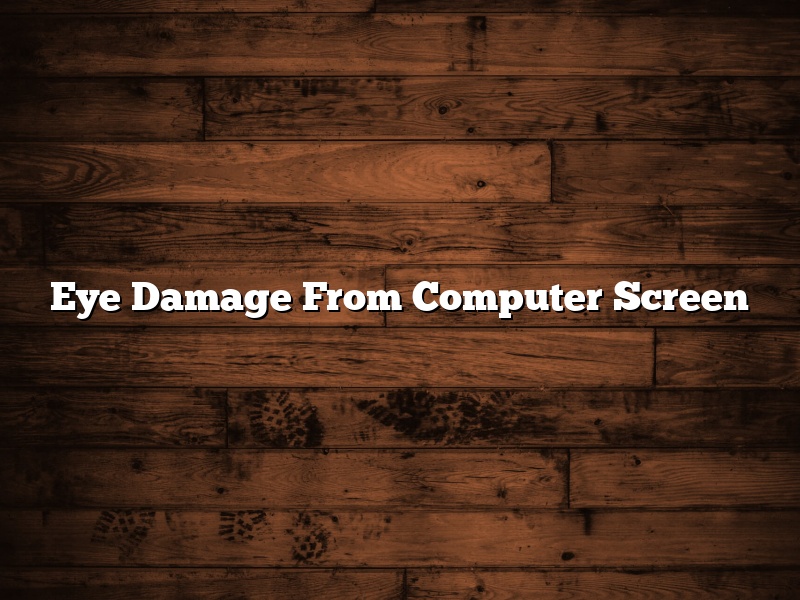Eye Damage from Computer Screen
Most people who use computers for work or pleasure are unaware of the risks associated with extended screen use. According to The Vision Council, close to 70 percent of American adults use digital devices for three or more hours a day, and the average person spends more than nine hours a day viewing digital screens.1
The most common problems associated with extended computer use are eyestrain, dry eyes, and headaches. All of these problems can be caused or exacerbated by blue light emitted from computer screens and other digital devices.
In this article, we’ll discuss the risks associated with blue light and ways to protect your eyes from the harmful effects of computer screens.
What is blue light?
Blue light is a type of visible light that is emitted from digital devices, including computer screens, smartphones, and tablets.
Blue light is especially harmful to the eyes because it is the most intense and energetic wavelength of visible light. When blue light enters the eye, it can cause eyestrain, dry eyes, and headaches.
What are the risks associated with blue light?
The risks associated with blue light are primarily due to the fact that blue light is so energetic. When blue light enters the eye, it can cause the pupil to constrict and the lens to contract. This can lead to eyestrain, dry eyes, and headaches.
In addition, blue light can also cause long-term damage to the eyes. Blue light can damage the retina and lead to vision problems, such as age-related macular degeneration.
How can I protect my eyes from blue light?
There are several ways to protect your eyes from blue light. Here are a few tips:
• Reduce your screen time. The more time you spend looking at a computer screen, the more likely you are to experience problems such as eyestrain, dry eyes, and headaches. Try to take breaks every 20 minutes or so to give your eyes a rest.
• Use a screen protector. A screen protector can help reduce the amount of blue light that enters your eyes.
• Dim the screen. If you’re experiencing problems such as eyestrain, dry eyes, or headaches, try dimming the screen. This can help reduce the amount of blue light that enters your eyes.
• Wear sunglasses. Sunglasses can help protect your eyes from blue light and other harmful UV rays.
In addition to these tips, you can also download a blue light filter app to your smartphone or tablet. These apps filter out blue light emissions from digital devices.
Conclusion
Blue light is a type of visible light that is emitted from digital devices, including computer screens, smartphones, and tablets. Blue light is especially harmful to the eyes because it is the most intense and energetic wavelength of visible light. When blue light enters the eye, it can cause eyestrain, dry eyes, and headaches. In addition, blue light can also cause long-term damage to the eyes. There are several ways to protect your eyes from blue light, including reducing your screen time, using a screen protector, dimming the screen, and wearing sunglasses.
Contents
- 1 How do you reverse eye damage from a computer?
- 2 Is computer eye damage permanent?
- 3 Is eye damage from screens reversible?
- 4 What are the symptoms of computer eye syndrome?
- 5 How long does it take for digital eye strain to go away?
- 6 Can you go blind from looking at a screen too long?
- 7 Can your eye heal itself?
How do you reverse eye damage from a computer?
Damage to the eyes from computer use is a common problem. It can cause eyestrain, headaches, and even vision loss. Fortunately, most cases of computer-related eye damage can be reversed with simple measures.
One of the most important things you can do to protect your eyes from computer-related damage is to take regular breaks. Get up and walk around for a few minutes every hour. This gives your eyes a chance to rest and helps to prevent eyestrain.
Another important step is to adjust your computer’s display settings. Make sure the text and images on the screen are bright enough, but not too bright. Also, make sure the screen is positioned so that you are looking straight at it.
If you already have eye damage from computer use, there are a few things you can do to help improve your vision. One is to use an eyeglass prescription for computer use. This can help to reduce eyestrain. You may also want to try using a computer filter. This is a special type of eyeglass that helps to reduce the amount of blue light that is emitted from the screen. Blue light is thought to be one of the main causes of computer-related eye damage.
If you have any other questions or concerns about computer-related eye damage, be sure to speak with your eye doctor.
Is computer eye damage permanent?
Is computer eye damage permanent?
This is a question that many computer users may ask themselves, especially if they are experiencing vision problems while using a computer. While it is possible for computer eye damage to be permanent, it is also possible for it to be reversed with the proper treatment.
The most common type of computer eye damage is eyestrain. This occurs when the eyes are overused and can cause a variety of vision problems, such as headaches, blurred vision, and dry eyes. Eyestrain is not usually permanent, and it can be treated by taking breaks from the computer, using eye drops, and wearing glasses.
Another type of computer eye damage that can occur is retinal damage. This is a more serious condition and can cause vision problems that are not reversible. Retinal damage is usually caused by looking at a computer screen for a long period of time without taking breaks. If you are experiencing any symptoms of retinal damage, such as blurred vision, eye pain, or seeing flashes of light, see your doctor right away.
While computer eye damage can be permanent, it is usually not. If you are experiencing any vision problems while using a computer, be sure to see a doctor to get the proper treatment.
Is eye damage from screens reversible?
There is a lot of concern over the potential damage screens can do to our eyes. With screens becoming such a ubiquitous part of our lives, it’s natural to worry about the long-term effects they may have on our vision. While there is some evidence that long-term screen use can cause eye damage, it’s not yet clear whether this damage is reversible.
One of the primary concerns with screen use is that it can cause eye fatigue. When we look at screens, we’re constantly focusing on objects that are in different places than our surroundings. This can cause our eyes to work harder than they normally would, leading to eye fatigue and, in some cases, pain.
There is some evidence that this eye fatigue can lead to irreversible damage. A study from 2016 found that people who spend more than three hours a day looking at screens are at a higher risk of developing age-related macular degeneration (AMD). AMD is a leading cause of vision loss in older adults, and there is no cure for it.
However, it’s important to note that the link between screen use and AMD is still not completely clear. Some experts believe that the increased risk of AMD is due to the fact that people who spend a lot of time on screens are also more likely to smoke and be overweight – two other risk factors for AMD.
Another concern with screen use is that it can cause digital eye strain. This is a condition that occurs when we look at screens for a long time. Symptoms of digital eye strain can include eye fatigue, headaches, and blurred vision.
There is some evidence that digital eye strain can lead to long-term damage to the eyes. A study from 2017 found that people who spend more than two hours a day looking at screens are at a higher risk of developing early-onset cataracts. Cataracts are a leading cause of vision loss in the world, and there is no cure for them.
Again, it’s important to note that the link between screen use and cataracts is still not completely clear. Some experts believe that the increased risk of cataracts is due to the fact that people who spend a lot of time on screens are also more likely to smoke and be overweight – two other risk factors for cataracts.
So, is eye damage from screens reversible?
At this point, it’s difficult to say. The evidence on the link between screen use and eye damage is still inconclusive. However, it’s important to be aware of the risks that screens may pose to our vision, and to take steps to protect our eyes, such as limiting our screen time and taking regular breaks.
What are the symptoms of computer eye syndrome?
Computer eye syndrome is a condition that can result from spending extended periods of time looking at a computer screen. The most common symptoms of computer eye syndrome are eye fatigue, headaches, and blurred vision.
Eye fatigue is the most common symptom of computer eye syndrome. It is caused by the constant use of the eyes to focus on a computer screen. This can cause the eyes to become tired and strained.
Headaches are also a common symptom of computer eye syndrome. They are often caused by eye fatigue, but can also be caused by glare from the computer screen.
Blurred vision is another common symptom of computer eye syndrome. It can be caused by the strain on the eyes from looking at a computer screen for extended periods of time.
How long does it take for digital eye strain to go away?
How long does it take for digital eye strain to go away?
This is a question that is asked frequently, as people who use digital devices for extended periods of time can often experience eye fatigue, blurred vision, and headaches. The good news is that, in most cases, digital eye strain goes away on its own within a day or two. However, there are some things you can do to speed up the process.
If you are experiencing digital eye strain, the best thing you can do is take a break. Get up and walk around, or close your eyes and relax for a few minutes. This will allow your eyes to rest and will help to relieve any discomfort you are feeling.
You can also try using artificial tears or eye drops. These will help to lubricate your eyes and will relieve any dryness or irritation.
Finally, make sure that you are drinking enough water. Dehydration can contribute to eye fatigue and discomfort, so drinking plenty of water will help to alleviate these symptoms.
In most cases, digital eye strain goes away on its own within a day or two. However, if you are experiencing ongoing discomfort, it is best to consult with your doctor.
Can you go blind from looking at a screen too long?
There is no one definitive answer to this question. Some people may be more susceptible to eye strain or other vision problems from looking at a screen for a long time than others. However, there are a few things you can do to reduce your risk of vision problems.
First, make sure you are taking breaks often. Try to look away from the screen for a few minutes every hour. Get up and walk around, or just close your eyes and take a few deep breaths.
Also, make sure you are using proper posture when you are looking at a screen. slump over and you will fatigue your eyes faster. Try to keep your head and neck in a neutral position and your eyes level with the top of the screen.
If you are experiencing any eye strain or other vision problems, talk to your doctor. They may be able to prescribe you with glasses or contacts that help reduce the strain on your eyes.
Can your eye heal itself?
Can your eye heal itself?
Yes, the eye can heal itself to some degree. The eye has a number of self-healing mechanisms that work to protect and restore the eye’s health.
The eye has a number of mechanisms that protect it from injury. The eyelids protect the eye from debris and the cornea from scratches. The cornea also has a number of self-healing mechanisms, including the production of new cells to replace damaged cells and the production of tears to wash away debris and infection.
The eye also has a number of mechanisms that restore its health. The eye is constantly renewing its cells, and new cells can replace damaged cells. The eye is also constantly regenerating its optic nerve. The optic nerve is the nerve that connects the eye to the brain, and it can regenerate if it is damaged.
The eye’s self-healing mechanisms are not perfect, and sometimes the eye can be damaged beyond the eye’s ability to heal itself. If the eye is severely damaged, it may need to be surgically repaired or replaced.




